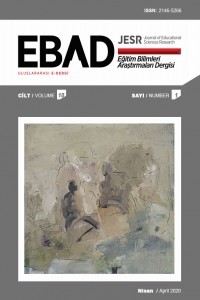[Yeni milenyumun öğrencilerden, öğrenme ortamlarından ve öğretim programlarından talepleri nelerdir?]
Eğitim, yarının dünyasının şekillendirilmesinde önemli bir rol oynadığı için, mevcut ve gelecekteki ekonomik, politik, sosyal, demografik ve teknolojik güçler tarafından şekillendirilmektedir. Bu nedenle, eğitim sistemlerinin kendilerini çevrelerindeki gelişmeler ve eğilimlerden soyutlaması mümkün değildir. Yaşamın her alanına hızlı değişim getirmesiyle ünlü bilgi çağı, sistemleri uyanık kalmaya ve bu değişimlere ayak uydurmaya zorlamaktadır. Tarama yöntemi ile desenlenen bu çalışmada, bilgi çağının; öğrenciler, okul ortamları ve öğretim programlarından talepleri analiz edilmeye çalışılmıştır. Öğrenci boyutu, bireysel, yerel ve küresel olmak üzere üç farklı bakış açısında irdelenmiştir. Bireysel bakış açısı, gerçek yaşam durumları için gerekli bilgileri öğrenmeyi ve öğrenmeyi öğrenme becerisini içermektedir. Yerel bakış açısı, ülkelerin varlıklarını sürdürmesinin, bilgiyi kullanabilen, üretebilen, sürekli güncelleyebilen ve de paylaşabilen bireylerin varlığına bağımlı olması ile ilişkilidir. Öğrenci boyutuna küresel bakış açısı ise, bireylerin yalnızca yaşadıkları kara parçasının değil, dünyanın bir üyesi olduklarının farkında olmalarını içermektedir. Bu standartları karşılayabilmek için öğrenme ortamları ve öğretim programları yapılandırmacı öğrenme kuramını temel almalı ve eğitim teknolojileri bunlara eklemlendirilmelidir
Anahtar Kelimeler:
Bilgi Çağı, Eğitim Teknolojileri, Yapılandırmacı Öğretim, Teknoloji Uzmanları
What are the demands of the new millennium from students, learning environments and the curriculum?
Although education plays an important role in shaping the world of tomorrow, it is also shaped by current and future economic, political, social, demographic, and technological forces. So, education systems can not isolate themselves from the developments and new trends around them. Information age, which is famous for the fast change of every aspect of our lives, forces education systems to be awake and keep up with these changes. In this study, it was aimed to analyse the demands of the information age from students, learning environments and the curriculum by using the survey method. Student dimension was explicated from three different perspectives; individual, local and global. The individual part is about learning the information that is necessary for real life issues and learning how to learn. The local perspective is about the need of people who can use, produce, continuously update and share knowledge for the countries to survive. The global point of view about the student dimension includes having an awareness of one’s membership on the earth not just the land piece they live on. To be able to meet these standards, learning environments and the curriculum should be based on the constructivist theory and education technologies should be integrated to them.
___
- Barney, D. (2007). The question of education in technological society. Brave new classrooms: Democratic education and the internet. (Edt: J. Lockard & M. Pegrum). New York: Peter Lang Publishing. pp. 271-284.
- Bazeli, M. J. & Robinson, R. S. (2001). Critical viewing to promote critical thinking. Education and technology: Critical and reflective practices. (Edt: R. Muffoletto). New Jersey: Hampton Press. pp. 69-91.
- Brooks, J. G. & Brooks, M. G. (1999). In search of understanding the case for constructivist classrooms. Alexandria, VA: Association for Supervision and Curriculum Development.
- Gagnon, G. W. Jr. & Collay, M. (2001). Designing for learning: Six elements in constructivist classrooms. California: Corwin Press.
- Jacobsen, D. A., Eggen, P. & Kauchak, D. (2006). Methods for teaching: Promoting student learning in K-12 classrooms. New Jersey: Merrill Prentice Hall.
- Jonassen, D. H., Marra, R. M., Howland, J. L. & Crismond, D. P. (2008). Meaningful learning with technology. New Jersey: Pearson/Prentice Hall.
- Maier, P. & Warren, A. (2000). Integrating technology in learning and teaching: A practical guide for educators. London: Kogan Page.
- Marzano, R. J. (2003). What works in schools: Translating research into action. Alexandria, VA: Association for Supervision and Curriculum Development.
- Mouza, C. (2005). Preparing teachers to teach with technology. Facilitating use of technology in urban classrooms: Principles for effective professional development. (Edt: C. Vrasidas & G.V. Glass). Greenwich: Information Age Publishing. pp. 133-149.
- Orhun, E. (2002). Computer based learning tools. Information and communication technologies in education: A focus on cognitive tools. (Edt: E. Orhun & P.A.M. Kommers). İzmir: Ege Üniversitesi Yayınları. pp. 17-26.
- Parkay, F. W., Anctil, E. J. & Hass, G. (2006). Curriculum planning: a Contemporary approach. Boston: Pearson Education, Inc.
- Sönmez, V. (2006). Gelecekteki olası eğitim sistemleri. Ankara: Anı yayıncılık.
- Wiske, M. S., Franz, K. R. & Breit, L. (2005). Teaching for understanding with technology. San Francisco: Jossey-Bass Education Series.
- Yelland, N. (2007). Shift to the future: Rethinking learning with new technologies in education. New York: Routledge Taylor & Francis Group.
- Başlangıç: 2011
- Yayıncı: Kürşad YILMAZ
Sayıdaki Diğer Makaleler
Okul yöneticilerinin etkililiği (Uşak ili örneği)
Okul yöneticilerinin teknoloji liderliğine ilişkin algıları: Metafor analizi örneği
Özge HACIFAZLIOĞLU, Şirin KARADENİZ, Gülay DALGIÇ
[Yeni bir sınav kültürü geliştirmek: olasılık sanatı]
İlköğretim öğretmenlerinin fen ve teknoloji dersinde yeni teknolojileri kullanmaya yönelik görüşleri
Örgüt metaforlarında liderlik: kavramsal bir çözümleme
Türkiye ve Almanya’daki coğrafya öğretim programlarının karşılaştırılması
